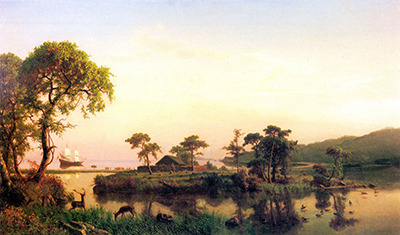Gosnold at Cuttyhunk was an 1858 painting by Albert Bierstadt. He painted the image on a canvas to give a romantic touch to the encampment of Gosnold at the West End Pond. It was first among many images the German-American artist painted to showcase the beauty of the American lands in the west that they settled.
This image showcases a village by the coast. In the background, one can see the ships approaching. These ships are most likely the settlers coming to new lands in America. There is also a village by the mouth of the sea that is surrounded by water on its way to the sea. In the foreground, there are tall trees and gazelles feeding on the grass. As a whole, the image showcases the natural beauty of the land. A place where wild animals roam freely and there is abundance of water and food. It speaks of the joy that came to him when he explored the new grounds. Albert used a style of painting called Luminism. This is a style of painting that was common from 1850 where the American landscape was painted with light effects on the land. In this image, he uses an aerial perspective and conceals the visible brushstrokes.
Albert used the style of painting to emphasize the area’s tranquillity and depict calm. This is followed by reflective water a sky that is both soft and hazy. This kind of painting developed from the Hudson River School. The school was more of coming together of minds of artists that had the same manner of thinking. The result of the style was often the realistic presentation of the area in a way that generated emotions to the reader. There is general attention to details in the image. The flowers of the trees in the foreground give a realistic feel of someone standing in a bush. The reflective image of the river essentially gives it some life compared to the water images drawn in other styles. In the case of Albert, he went in to show submerged logs as well as roots of the tall trees in detail.
Another striking thing about the image is that there is little personality seen in the image. The artist is focused on bringing the beauty of the land that he does away with any trademarks that may show his personality. In addition, Albert used realistic hues to present various items in the image. The viewer can see the light without having to look for shadows. One can differentiate various items from the good selection of tones for each item. This landscape image inspired many other images that Albert painted later in life that included the Sierra Nevada, California in 1868 and The Last of the Buffalo in 1888. He was a prolific painter who created over 500 works of art during his lifetime. He gave the modern world a feel of European expansion into the American Wild West.




